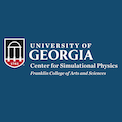Events Calendar View
-
Mathematical Physics Seminar
Oct 2, 2013
Summation of Fourier series, cont.
-
Departmental Colloquium
Oct 3, 2013
The strong interaction: status, strategies, and perspectives.
Nuclear physics investigates the origin and structure of strongly interacting matter: the atomic nucleus, the proton and the neutron, and the quarks. The interaction between quarks has a remarkable property called asymptotic freedom: it decreases for small distances between the quarks. It is widely believed that quarks do not exist as free particles because a separation is prevented by the growing forces. Unfortunately, the growing coupling strengths make calculations for larger distances virtually impossible. There are two strategies to make progress. Theory has developed lattice simulations of the strong interaction. Experimentally, one studies meson production in nuclear reactions. The Thomas Jefferson National Laboratory has taken a leading role in this field using photonuclear reactions as a probe to produce Baryon resonances and to study their decays in a large energy region ranging from the reaction threshold up to approximately 3 GeV. The extraction of resonance properties from the data at large energies is non-trivial, as one has to take into account the final state interactions between the produced hadrons. Nuclear theory has made progress during the last decade by developing effective theories of meson-baryon reactions that can describe the data.
-
CSP Lunch Seminar
Oct 8, 2013
Sticking of atomic hydrogen on amorphous water ice, Pt. 2

Guest: Vijay Veeraghattam, UGA Center for Simulational Physics
Tuesday, October 8, 2013 12:30 pm - 1:30 pm
Location: CSP Conference Room (Room 322) -
Mathematical Physics Seminar
Oct 9, 2013
Summation of Fourier series, concluded
-
Departmental Colloquium
Oct 10, 2013
Kondo Phenomenon at Steady-State Nonequilibrium
Nonequilibrium Kondo problem is one of long standing problems in condensed matter physics. For this reason, all of the experimental observations for the tunneling conductance of various Kondo-involved mesoscopic systems are not properly explained. In this colloquium, I will introduce basic Kondo physics in equilibrium and extend the discussion to steady-state nonequilibrium in which entangled Kondo singlets perform coherent tunneling depending on the amount of bias. Then, I clarify that the Kondo phenomenon at steady-state nonequilibrium is the side peaks appearing in dI/dV vs. V curve, and I reproduce the dI/dV line shapes of various mesoscopic Kondo systems such as quantum dot single-electron transistor, quantum point contact, and adsorbed magnetized atom on a metallic substrate. I will show that multilayer graphene and high-Tc superconductor can be treated in the same category. I will introduce the theoretical method to obtain the on-site Green’s function for the two-reservoir Anderson impurity model under bias, which gives the tunneling conductance mentioned above.
-
CSP Lunch Seminar
Oct 15, 2013
A study of diffusion of a single polymer on a surface by molecular dynamics simulatio
Page 47 of 121, showing 6 records out of 723 total, starting on record 277, ending on 282


